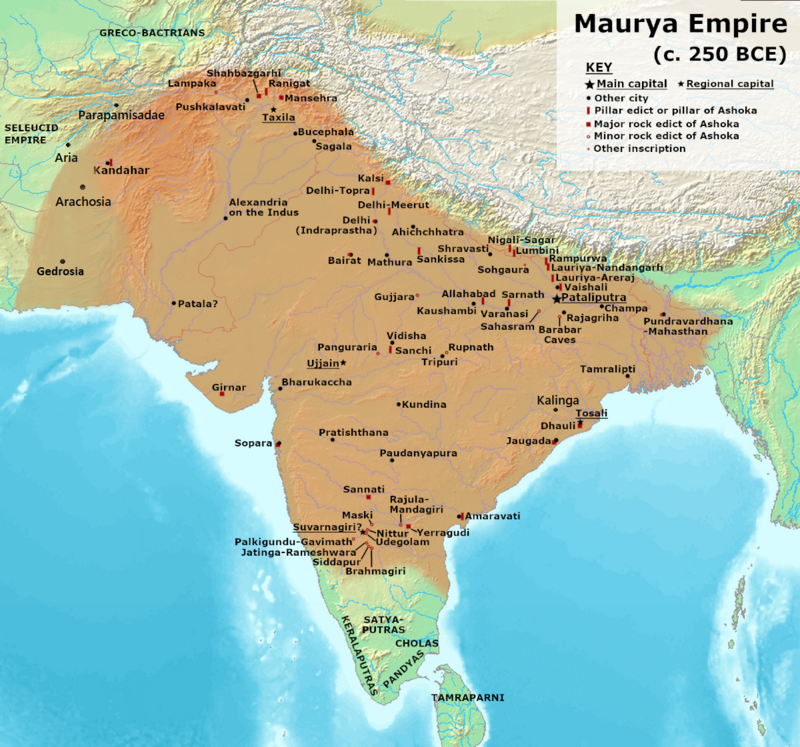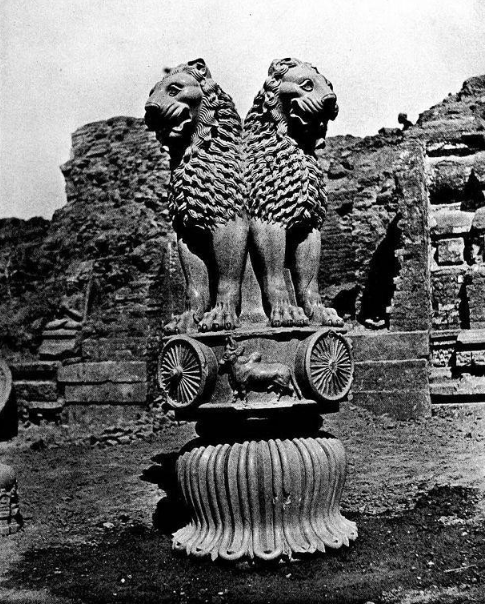
Mauryan Empire : The Maurya Empire (322-185 BCE), ruled by the Maurya dynasty, was a geographically extensive and powerful political and military empire in ancient India. Chandragupta Maurya founded the empire in 322 BCE after overthrowing the Nanda dynasty. The Mauryan Empire, a state centered in Pataliputra (later Patna) near the confluence of the Son and Ganges (Ganga) rivers in ancient India, lasted from 321 to 185 BCE. It was the first empire to cover most of the Indian subcontinent.
Mauryan Empire
The Maurya Empire, founded around 321 BC and ending in 185 BC, was the first pan-Indian empire, a state that covered most of the Indian subcontinent. It stretched across central and northern India and parts of modern-day Iran. As Alexander the Great's power began to wane, Chandragupta Maurya, the first leader of the Maurya Empire, began to consolidate territory. Alexander's death in 323 BC left a power vacuum. Chandragupta took advantage, raising an army and overthrowing the Nanda power in Magadha, present-day eastern India, thus establishing the Mauryan Empire.
Mauryan Empire Overview
In ancient India, many significant empires evolved. One of them was the Mauryan Empire. Established by Chandragupta Maurya, the Mauryan Empire was an important dynasty in our history.
| Mauryan Empire Overview | |
| Aspects | Details/Key Points |
| Founder | Chandragupta Maurya |
| Capital | Pataliputra (Modern-day Patna, Bihar) |
| Duration | 322 BCE to 185 BCE |
| Extent of Empire | From present-day Afghanistan in the west to Bangladesh in the east, and from the Himalayas in the north to the Deccan Plateau in the south |
| Administrative Structure | Centralized administration with provinces ruled by governors; Division of the empire into districts (Janapadas) governed by officials; Extensive bureaucracy. |
| Notable Rulers | Chandragupta Maurya, Bindusara, Ashoka the Great |
| Military Strength | A large standing army, aided by a sophisticated espionage system, Utilized war elephants as a significant military asset |
| Economic System | Agrarian economy with significant revenue from agriculture; Trade and commerce flourished along well-maintained trade routes. |
| Religious Policies | Initially, favored Jainism but later adopted a policy of religious tolerance; Ashoka converted to Buddhism and spread its teachings throughout the empire. |
| Major Achievements | Unified a vast territory under one rule, Constructed an extensive network of roads, and promoted trade; Ashoka's rock edicts and pillars spread moral and ethical teachings. |
| Decline and Successors | Declined after Ashoka's death due to weak successors and external invasions; Overthrown by the Sunga dynasty in 185 BCE |
Mauryan Empire Origin and Expansion

- Following Alexander the Great's demise in 323 BCE, Chandragupta Maurya, the Mauryan dynasty's founder, seized the Punjab region from the southeastern fringes of Alexander's former empire.
- With peace secured along the western border, Chandragupta directed his military efforts eastward and southward. By the end of his reign, he had extended his empire across northern India.
- Bindusara, Chandragupta's son, continued the empire's expansion deep into the Deccan, reaching the region now known as Karnataka.
- Bindusara's son, Ashoka (reigned c. 265–238 BCE or c. 273–232 BCE), added Kalinga to the vast empire.
- However, this addition marked the empire's final expansion, as the brutal conquest of Kalinga prompted Ashoka to renounce military conquest.
- Instead of military pursuits, Ashoka embraced Buddhism and established dharma as the state ideology.
- After Ashoka's death, the empire contracted due to invasions, defections by southern princes, and disputes over succession.
- The last ruler, Brihadratha, was assassinated in 185 BCE by his Brahman commander-in-chief, Pushyamitra, who founded the Shunga dynasty, which ruled central India for about a century.
Mauryan Empire Rulers
Important rulers of the Mauryan Dynasty are:
Chandragupta Maurya (c. 321 BCE-300 BCE)
- He was the founder of the Mauryan empire with the help of Chanakya.
- Chandragupta defeated Seleucus Nicator (General of Alexander). Chanakya provided the strategy while Chandra Gupta executed it.
- A shudra woman in Nanda’s court (Mura) was his mother.
- He converted to Jainism and went to Shravanabelagola with Bhadrabahu.
- Megasthenes was the Greek ambassador at Chandragupta’s court, and He is the author of Indica.
- Chanakya was the chief advisor to Chandragupta Maurya, the founder of the Maurya dynasty.
- Chanakya wrote Arthshastra, and it is the most important source of the Mauryan Empire.
- MudraRakshasa was written by Visakha Datta, and it describes the economic conditions under the Mauryas.
- Chanakya is also called Kautilya or Vishnugupta.
Bindusara (c. 298 BCE-273 BCE)
- He was called Amitraghat (slayer of foes) by Greek writers.
- Deimachos visited his court and was said to have conquered the land between the Arabian Sea and the Bay of Bengal.
- He appointed his son Ashoka as the governor of Ujjain.
Ashoka (c. 268 BCE-233 BCE)
- Title: Devanamapriya (dear to gods).
- He was one of the most powerful kings of the Indian subcontinent in ancient times.
- Religion (Buddhism) and Symbol (Lion).
- For the first 8 years, he was ruled like a cruel king and maintained discipline.
- James Princep deciphered the language(scripts) used in inscriptions.
- Kalinga War (261 BC): After the Kalinga War, he converted to Buddhism. The massacre in this war had moved him.
- He held the third Buddhist council.
- His policy of Dhamma was a broad concept which covered the code of conduct, way of life, and set of principles that people should adopt in their daily life.
- He was known for his policy of peace and non-aggression.
- Ashoka built Sanchi Stupa.
- Ashoka's rock edicts mention Tamraparni (as "Tambapanni") in connection with his foreign missions. This suggests that Sri Lanka was known as Tamraparni during the reign of Ashoka in the 3rd century BCE.
- Imperial currency of Mauryas (The Punch-marked coins).
- Barabar Caves near Gaya is the e.g. of Mauryan artisans who started the practice of carving caves for monks to live in.
- Two types of detectives (Gudda Purushas): Sansthan(Stationary) and Sanchari(Wandering).
- Ashoka's tenure marked the peak of the Maurya dynasty. After Ashoka's death, the dynasty weakened and successive monarchs ruled for only a few years. The last Mauryan king, Brihadratha, was slain by his military commander, Pushyamitra Sunga, in 187 BCE.
Mauryan Empire Achievements
Chanakya, a brilliant strategist and economist, and Chandragupta Maurya, a young prince, founded the Mauryan Empire in the Magadha region of India. After Alexander the Great's death in 323 BCE, Chandragupta Maurya assembled an army, overthrew the Nanda Empire in the Magadha region of eastern India, and established the Mauryan Empire.
| Mauryan Empire Achievements | |
| Achievements | Description |
| Establishment of a vast Empire | Chandragupta Maurya, the founder of the Mauryan Empire, unified most of the Indian subcontinent under his rule. |
| Development of a strong central administration | The Mauryan Empire had a well-organized and efficient bureaucracy that helped to maintain law and order and collect taxes. |
| Promotion of trade and commerce | The Mauryan Empire built roads, canals, and ports to facilitate trade and commerce. |
| Patronage of arts and culture | The Mauryan Empire promoted the development of arts and culture, including literature, music, and architecture. |
| Spread of Buddhism | The Mauryan Empire played a key role in the spread of Buddhism throughout India and beyond. |
| Enactment of social reforms |
The Mauryan Empire enacted a number of social reforms, including the abolition of slavery and the promotion of women's rights. |
Mauryan Empire Society
The Mauryas inherited a complex and diverse society, helped reinforce the caste system, tolerated different religious beliefs and practices, and significantly contributed to its development.
| Mauryan Empire Society | |
| Varna System | During the Mauryan period, the Varna system was well-established. It consisted of four main categories: Brahman, Kshatriya, Vaishya, and Shudra. Each Varna had specific roles and responsibilities assigned based on their social status. |
| Additional Varna Sankara | In addition to the four main Varnas, Kautilya's Arthashastra mentioned various Varnashankaras like Nishad, Magadh, Sut, Veg, Chandals, etc. Kautilya categorized them as Shudras, indicating a hierarchical social structure. |
| Sati System | Kautilya's Arthashastra does not provide information about the sati system. However, Strabo noted that the practice of sati was prevalent among the Kath tribes of Punjab, indicating that it was observed in certain communities during the Mauryan period. |
| Entertainment/Amusement | Mauryan society had diverse forms of entertainment. Activities like hunting, acting, magic, drama, and painting were popular. Citizens engaged in entertainment through events like Vihara-yatra, Samaj gatherings, and Pravahana. |
Mauryan Art and Architecture
Mauryan art, a royal art supported by Mauryan rulers, especially Ashoka, flourished between the 4th and 2nd centuries BC under the Mauryan Empire, the first empire to control much of the Indian subcontinent. Therefore, it marked a significant shift in Indian art from wood to stone. Among the most notable survivors of Mauryan art are pillars, stupas, and caverns.

| Mauryan Art and Architecture | |
| Art Form | Description |
| Court Art | |
| Royal Buildings | The palaces of the Mauryan empire were immense and elaborate, with multiple entrances and hundreds of rooms. |
| Pillars | Ashoka used pillars to propagate Dhamma, his Buddhist teachings. The pillars were often decorated with capitals in the form of animals, such as lions and elephants. The Lion Capital of Ashoka, a sculpture erected by the Mauryan emperor Ashoka in Sarnath, India, c. 250 BCE, features four life-sized lions set back to back on a drum-shaped abacus. |
| Caves | The Mauryan period saw the beginning of rock-cut cave architecture. The Barabar and Nagarjuni hills contain several caves built by Ashoka and Dashratha. |
| Stupas | Stupas were burial mounds prevalent in India from the Vedic period. Ashoka built several stupas, including the famous Sanchi stupa. |
| Viharas | Viharas were shelters for Buddhist monks. Ashoka built several viharas, including the Ashokaram vihara and Kakuttaram vihara in Patliputra. |
| Folk Art | |
| Stone Sculpture | Several large stone sculptures have been found at various sites in and around Patna, Mathura, and Madhya Pradesh. Many of them represent Yaksha and Yakshi. |
| Terracotta | Terracotta figurines flourished with the expansion of urban centers. They include male and female figurines, animals, and carts. |
| Pottery | Pottery of the Mauryan period is generally referred to as Northern Black Polished Ware (NBPW). Kosambi and Patliputra were the centers of NBPW pottery. |
Mauryan Empire Economy
The Maurya Empire stretched over parts of modern Iran and almost the entire Indian subcontinent, except the southern peninsular region. It was the first all-India empire.
- The Mauryan Empire was a period of great economic prosperity. The primary source of revenue for the state was land revenue, which was collected from both state and private land.
- The economy of the Mauryan Empire was based on agriculture, animal husbandry, and trade. The principal crops were rice, barley, millet, and wheat.
- The main industries during the Mauryan period were spinning and weaving. The state also monopolized some products, such as wine, salt, mines, ships, and forests.
- The Mauryan Empire had a well-developed communication and transportation system. There were four main roads: Uttarapath, Dakshinapath, a road connecting Bhrigukachchha to Mathura, and a road connecting Champa to Kaushambi.
- The Mauryan Empire had a thriving external trade with countries in the west, such as Syria, Egypt, and Greece, and countries in the east, such as Southeast Asia and China. The chief export articles were spices, pearls, diamonds, sandalwood, ivory, cotton cloth, silk yarn, and muslin. The principal imports were linen, silver, gold, and dry fruits.
- The Mauryan Empire also had a state monopoly on mining and metallurgy. The mining superintendent was responsible for prospecting new mines and reopening old and disused ones.
- The Mauryan Empire used a variety of coins, including gold coins (Nishaka/Suvarna), silver coins (Karshapan/Dharan/Pann), and copper coins (Mashak/Kakini). The state had its own minting factories, which the Lakshanadhyaksha headed. The examiner of coins was known as the Rupdarshaka.
Mauryan Administration
The Mauryan administration was a well-organized system with a centralized structure. It featured a comprehensive hierarchy of officials and institutions responsible for various aspects of governance.
| Mauryan Administration | |
| Position/Aspect | Responsibilities/Details |
| King |
|
| Ministries/Departments |
|
| Ministers |
|
| Paura-Janapada |
|
| Governor/Viceroy |
|
| District Administration |
|
| Village Administration |
|
| Municipal Administration |
|
| Judicial Administration |
|
| Espionage |
|
Mauryan Military Organisation
The Mauryan army was one of the most powerful and well-organized armies of its time. It was three times larger than the army of the Nanda dynasty, which the Mauryans overthrew. The Mauryan army consisted of four main branches: infantry, cavalry, elephants, and chariots.
- Infantry: The infantry was the largest branch of the Mauryan army, and it was made up of professional soldiers. The infantrymen were armed with a variety of weapons, including swords, spears, bows, and arrows. They were also protected by shields and armor.
- Cavalry: The cavalry was the second largest branch of the Mauryan army. The cavalrymen were mounted on horses and armed with lances and swords. They were used for scouting, raiding, and flanking attacks.
- Elephants: Elephants were a key part of the Mauryan army. They were used to charge at enemy lines and break their formations. Elephants were also used to transport troops and supplies.
- Chariots: Chariots were another important part of the Mauryan army. They were used to transport warriors and archers into battle. Chariots were also used to break through enemy lines and sow chaos.
- The Mauryan army also had a camel corps and an ass corps. These corps were used for transportation and logistics.
Mauryan Empire Rivals and War
| Mauryan Empire Rivals and War | |||
| Campaign | Year | Leader | Description |
| Pataliputra | 319 BC | Chanakya | Confronts the Nanda dynasty with mercenaries. |
| Takshashila | 316 BC | Chandragupta | With the support of the Indian king Ambhi, the Thracian general Eudamus defended Taxila from an attack by Chandragupta. |
| Gandhara | 304 BC | Chandragupta | Meets Seleucus I Nicator's attack on Gandhara on the banks of the Indus River. |
| Revolt in the Provinces | 275 BC | Ashoka | Chandragupta's grandson Ashoka sent a relief force to lift a rebel siege of Taxila and free the elderly Chanakya, who was hiding in the city's palace. |
| Khashas | 274 BC | Bindusara | Attacks the mountain strongholds of the independent Khasha rulers and overthrows their alliance. |
| Kalinga | 261 BC | Ashoka | Ashoka, the Maurya emperor, invaded Kalinga, an independent feudal kingdom on the east coast of India. The battle was fought in the Dhauli Hills and was among the largest and deadliest in Indian history. Ashoka was victorious, but the war caused immense bloodshed and suffering. |
Decline and Disintegration of the Mauryan Empire
The Mauryan Empire was the first empire in the history of India, and it reached its peak under the rule of Ashoka the Great. However, after Ashoka's death, the empire began to decline, and it eventually disintegrated in 185 BCE. There are a number of factors that contributed to the decline of the Mauryan Empire.
- One important factor was the weakness of Ashoka's successors. None of Ashoka's sons were able to match his ability as a ruler, and the empire quickly became destabilized.
- The pacific policy of Ashoka.
- Financial Crisis -During the Mauryan age, a huge expenditure was made on maintaining the army and bureaucracy. thus resulting in economic constraints.
- The Mauryan Empire was vulnerable to foreign invasions. The empire's northwestern frontier was particularly vulnerable and was invaded by the Bactrian Greeks in 185 BCE. This invasion marked the end of the Mauryan Empire.
Mauryan Empire FAQs
Who was the first Mauryan King?
What was the capital of the Mauryan Empire?
Who was the son of Ashoka?
Who came after Ashoka?










